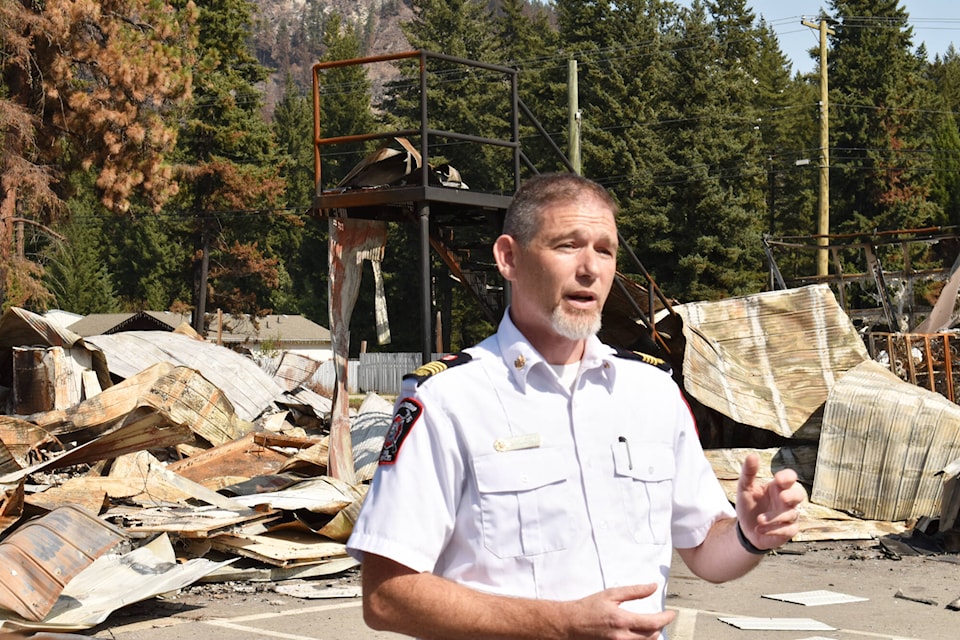By Barb Brouwer
Contributor
This 2023 Bush Creek East wildfire moved with lightning speed. Recovery however, is estimated to take up to three years or more.
Michael Higgins, director of Climate Readiness and Community Recovery for Colliers Project Leaders Recovery Team, bought directors up to speed on recovery efforts at the Columbia Shuswap Regional District (CSRD) board meeting on Nov. 16.
Colliers Canada is the consultant group hired by the CSRD to assist with recovery efforts.
Prior to Higgins’ report, the board approved a proposed governance structure that takes a project management-based approach to the recovery process. Noting his extensive experience in government and local government rather than project management, Higgins pointed out he has a team of project managers.
“We are making sure we are taking these large incidents and turning them into small operationalized projects,” he said, noting he sees himself as the primary interpreter between project managers and local government and their clients. “We appreciates that they are impacting people, impacting infrastructure and community structures, but to make them manageable, accountable and financially solid, we need to look at them as projects.”
The CSRD board will be updated on the status of the recovery projects as major milestones are completed.
Members of CSRD’s senior administrative team and department heads are part of a Recovery Management Project Team that provides day-to-day management and operation of the project, reviews recommendations from the working group and provides recommendations to the steering committee.
Higgins said the working group is a tactical group that comes up with ways to address issues that affect people within a local context. This is being done on three fronts: from a social perspective that focuses on people’s unmet needs, on an infrastructure perspective that focuses on redevelopment and rebuilding, including replacing the Scotch Creek Firehall, and on a development services perspective, focusing on permitting and solid waste management.
“Completed tasks include transitioning from an emergency operations centre ‘emergency tempo’ of activity around the wildfire to a more recovery based tempo and recovery based actions,” said Higgins, noting he had worked with EOC to identify primary tasks, and approve the governance model, which he described as a very important key item that will help to move recovery forward over the long term. “Recovery is a long-term prospect and you’ll see some areas that might not have previously been considered a typical recovery project based on scope scale and complexity.”
Work plans have been developed and several meetings have taken place between various groups.
Some rebuilding will likely be complicated by new heritage and riparian legislation that wasn’t in place when many structures were built. Work is being done to streamline the process so residents are not held up unduly.
Colliers has presented government with a post-event expenditure authorization review to provide recommendations on how best to move forward in the future.
Higgins says work continues in the Wellness and Housing section, the largest of the tasks, with some residents still receiving emergency social services. An online survey gave residents affected by the wildfire the opportunity to share their thoughts, and interviews have been held with emergency response stakeholders. As well, work has been done with the board, Shuswap Emergency Program, emergency social services contractors and staff in order to capture the lessons learned from the Bush Creek East Wildfire.
Read more: Footage of West Kelowna, Shuswap wildfires sought for research project
Read more: ‘There’s no quick answer’: Shuswap community questions wildfire officials
Looking ahead, Higgins said upcoming tasks include work around around property assessments and tax losses, a policy on building and temporary permits, critical infrastructure insurance review and replacing the firehall.
On the environmental side, work is focusing on debris management and how much CSRD landfills can expect to receive, how much of the debris is contaminated and how to make sure the landfills continue to be operated to meet provincial regulations.
Residents will receive Ministry of Environment testing guidance and resident debris testing support will be provided. The province is meeting to establish guidelines for residents in riparian areas and where necessary, required next steps will be confirmed with regard to geotechnical hazard assessment which were conducted in early fall.
Communication with residents is being conducted with monthly public updates and social media stories, and an open house is being planned.
Following his presentation, Higgins responded to Golden Mayor Ron Oszust’s question about whether the recovery plan is based on an established template that is taken to different events.
“No, it’s not a template; our primary role is to come into communities and organizations, get a feel for what the circumstance has been and develop a structure that meets their needs,” Higgins replied. “This is brand new for local government in B.C. and is designed to be able to bolt onto the side of a local government, whether regional district or municipalities rather than create another organization.”
Sign up for our newsletter to get Salmon Arm stories in your inbox every morning.
